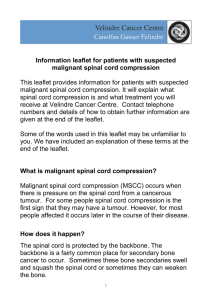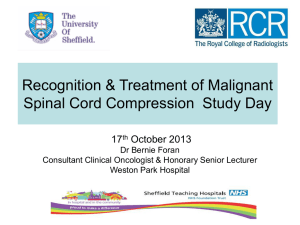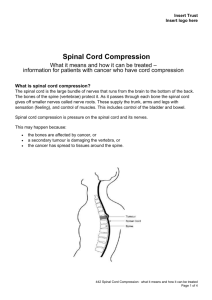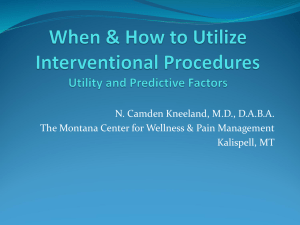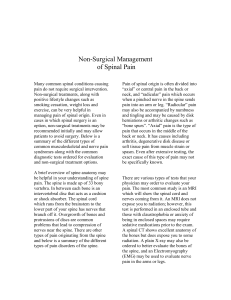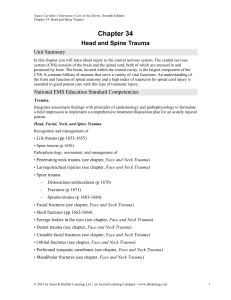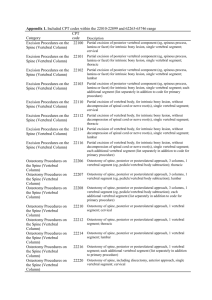MSCC and Physiotherapy
advertisement
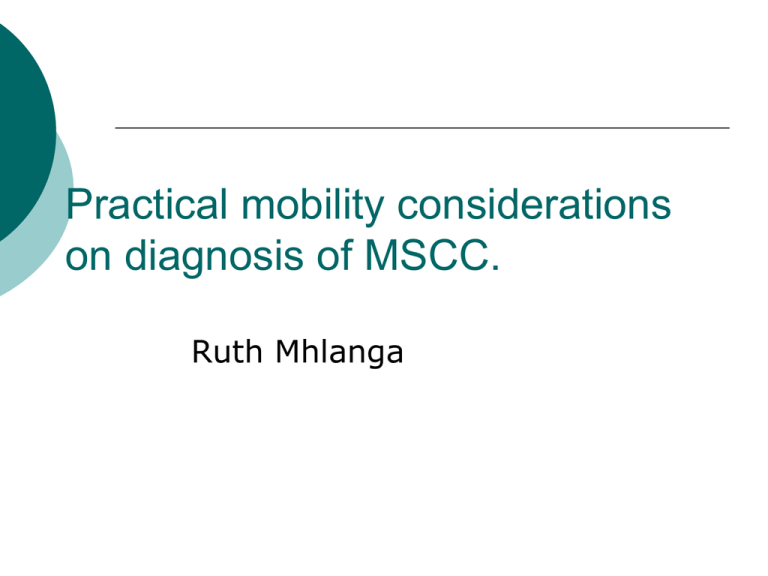
Practical mobility considerations on diagnosis of MSCC. Ruth Mhlanga What it is Compression of the dural sac and its contents (spinal cord and or cauda equina) by an extradural tumour mass (Loblaw et al 2004). Spinal cord or cauda equina compression by direct pressure and or induction of vertebral collapse or instability by metastatic spread or direct extension of malignancy that threatens or causes neurological disabilty(NICE 2008) Minimum radiological evidence is indentation of theca at level of clinical features. Cauda equina How this happens Effects Compression causes inflammation , oedema, mechanical compression which in turn leads to neural damage, vascular impairment and oxygen deprivation to the cord (Meyering 2008) Could result in infarction of cord. Range from sensory, motor, autonomic, severe pain to complete paralysis (Drudge Coates and Rajbabu 2008 pg4). Symptoms - - Spinal metastasis Thoracic or cervical spine Progressive lumbar spine pain Severe unremitting lumbar spine pain. Worse with straining Pain preventing sleep at night Localised spinal tenderness. Neurological signs and symptoms - Radicular pain Limb weakness Difficulty with mobs Sensory loss Bowel and bladder dysfunction Any other signs of spine or cauda equina involvement. Differential diagnoses Herniated disk Haematoma Abscess Primary tumour Extradural lesion Myelopathy Metastasis. (London Health Sciences Centre 2004) INFORM MSCC COORDINATIOR WITHIN 24 HOURS IMMEDIATE Pain in T or L spine Progressive C spine pain Pain ++ on straining Pain preventing sleep Neuro Sx or signs Includes radicular pain TREATMENT MOBILISATION STEROIDS Nurse flat with spine neutral until spinal/neuro stability ensured Gradual sitting over 3-4 hours Dexamethasone 16mgs until RT/surgery Reduce over 5-7 days and stop Increase if neuro deterioration PAIN CONTROL DEFINITIVE TREATMENT Causal pathway of MSCC(Loblaw and Lapierre1998 and 2005) Asymptomatic MSCC Screening Biologics Biphosphonates Chemotherapy Symptomatic Favourable MSCC Outcome Reducing delays Improved Treatment Stable or unstable Can not always be ascertained using radiology alone (Pease et al 2004). Lessons learnt from osteoporosis indicate that fracture does not equal instability. Spinal ligaments also contribute to spinal stability. Images are just a snapshot in time therefore need to complement with clinical signs and symptoms. Stable or unstable Spinal Protection Logrolling only appropriate where disease or surgery have compromised spinal stability. Mobilise patients unsuited to surgical stabilisation once risk of causing lesion extension has been assessed as acceptable to all parties or where patient is enabled to make an informed quality of life decision. So what do we do? If MRI unavailable and patient in pain….nurse flat. MRI available and consultants report no radiological instability bed rest (not necessarily flat) until physiotherapy assessment. MRI available and no plan for treatment – bed rest. Doctors discuss with patient about possible deterioration and if patient aware of risks, bed rest until physiotherapy assessment. Consideration MRI Pain and other neurological symptoms Mobility Action Not available Flat bed rest. Available Stable spine - bed rest until physio assessment. Unstable – flat bed rest Present Flat bed rest or as tolerated. Not present Bed rest until clearance from consultant. Pain worse with mobility Reposition until symptom reversed. Monitor, may need re-referral to surgeons. Completely absent Consultant d/w with patient. Sit up as tolerated Present but with pain Bed rest until physiotherapy assessment Present with no pain Supervised mobilisation Mobilisation Patients with an unstable spine to be nursed flat. Once stability ascertained sit up gradually to 60 degrees over 3-4 hrs If tolerates with all other vital signs stable check for sitting balance and mobilise as able. If neurology deteriorates return to position of reversal of symptoms, reassess stability of spine. If unsuitable for definitive treatment then mobilise as able . Ensure patient aware of risks. Stable or unstable Stable Mobile Pain usually eases with steroids. Keep mobile Unstable - Can be mobile - Pain on movt - Stabilise spine before mobs Treatment outcomes 60-90% of patients get relief from pain from radiotherapy and steroids. 60-100% of those who are mobile maintain their mobility status (Helweg Larsen et al 2000/ Loblaw et al 2004) Survivors are at high risk of recurrence or new compression. NICE Guidance and Rehabilitation Discharge planning and rehabilitation should be initiated on admission. Should include patient and carers, oncology team, surgery (where appropriate), rehabilitation, community, SPCT where appropriate. Patient centred. Consider patients’ preferred place of care. Prior to discharge Ensure family aware of what patient able to do and support and guidance given prior to discharge. If patient mobile ensure patient aware of new symptoms.? NECN MSCC patient information leaflet. MDT to address mobility issues including spinal support with braces and collars as well as handover to their colleagues where appropriate. Medical concerns including pain and stability addressed prior to discharge. References Drudge-Coates L. and Rajbabu(2008) Diagnosis and management of Spinal cord compression part 2. International Journal of Palliative Nursing Vol 14. No 4 Loblaw D.A and Lapierre L.J (1998)Emergency treatment of Malignant extradural spinal cord Compression: An evidence based guide. Journal of clinical Oncology American Society of Clinical oncology16.1613-1624 Loblaw D.A, Perry J.,Chambers A. and Lapierre N.J. Systematic Review of the diagnosis and management of malignant spinal cord compression: The cancer care Ontario Practice Guidelines Initiatives Neuro-Oncology Disease site Group.Journal of Clinical Oncology.American Society of Clinical Oncology 23:2028-2037 London Health Sciences centre 2004. Meyering S.M. (2008) Spinal cord compression and vertebral metastasis diagnosed in correlation with TC-99 m H/MDP scan. Nuclear Medicine Vol 5. No 1. NICE guidelines.(2008) Metastatic Spinal Cord Compression Diagnosis and management of adults at risk of and with metastatic spinal cord compression. Pease N.J, Harris R.J, Finlay I.G. Development and audit of a care pathway for the management of patients with suspected malignant spinal cord compression. Physiotherapy, 2004 Mar, vol 90, no 1, pg 27-34


